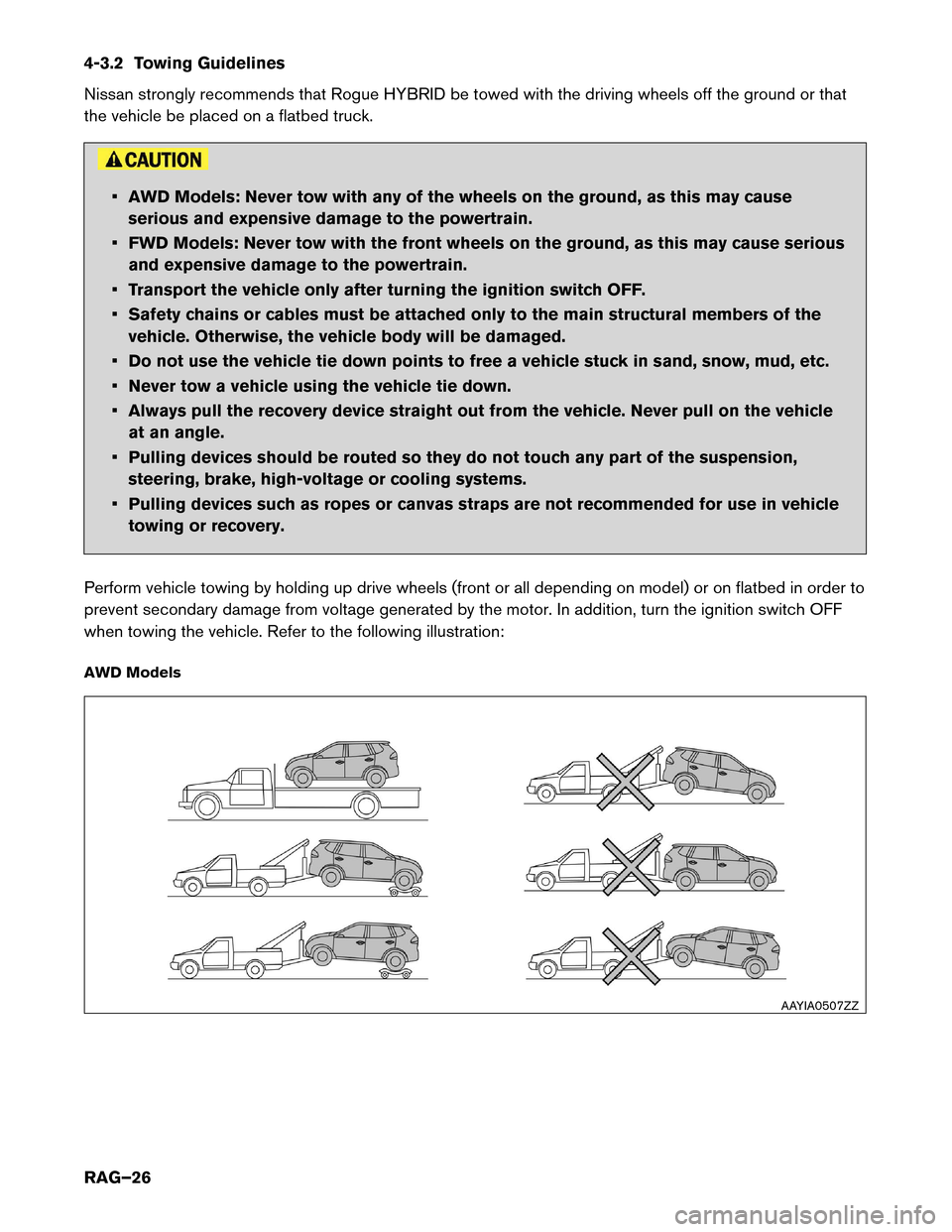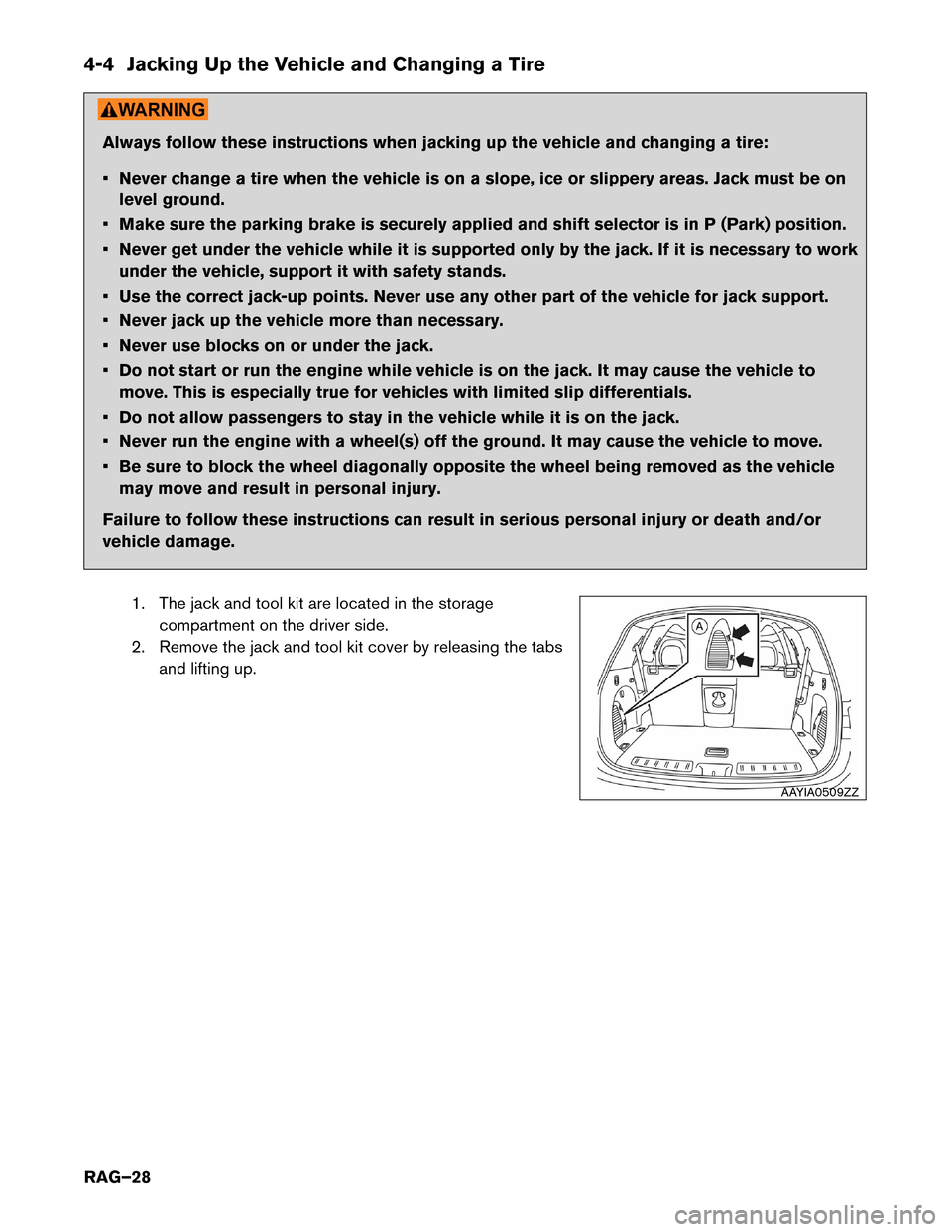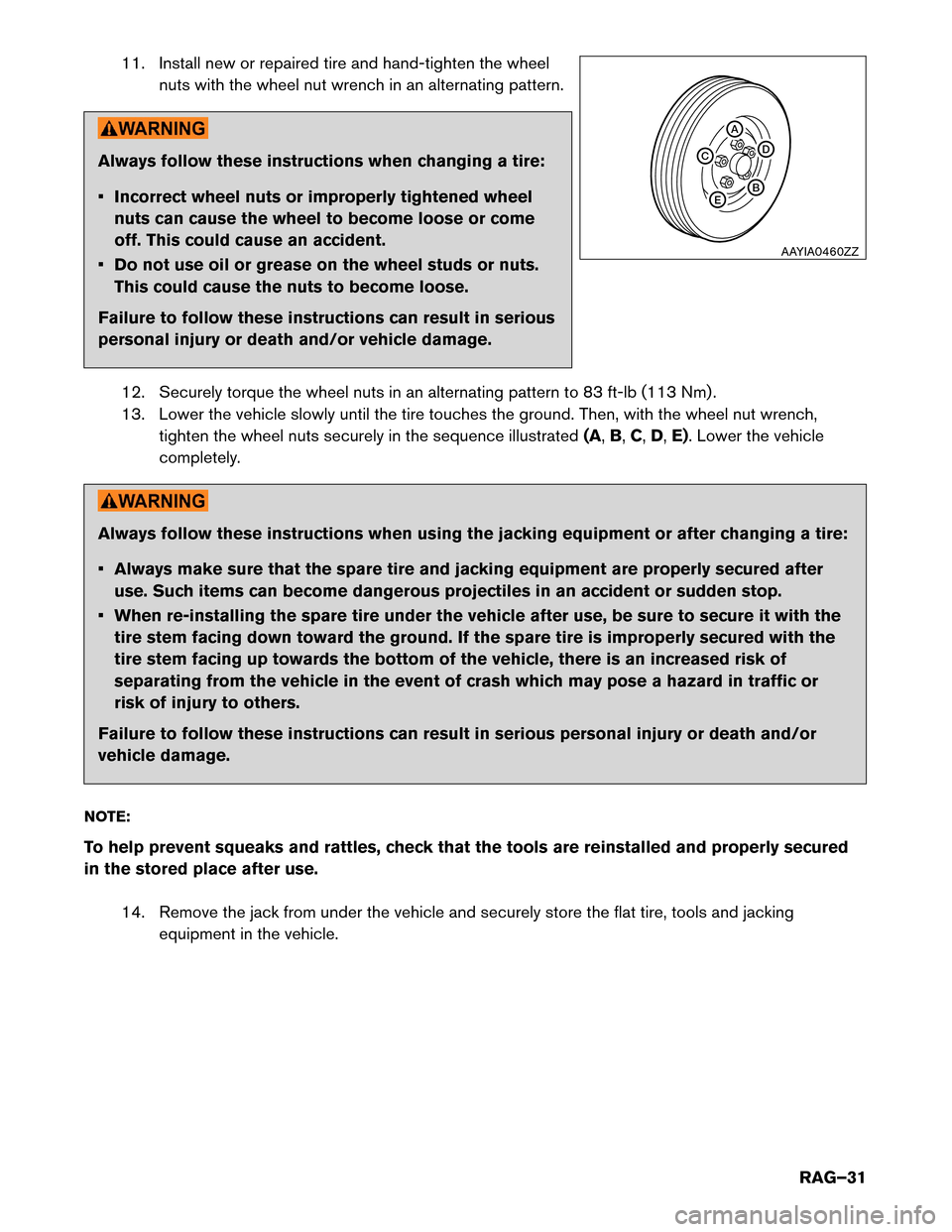Page 25 of 38
4-2 Tools Installed in the Vehicle
The
tool kit is housed along with the jack located inside the rear cargo area.
The jack and tool kit are located in the storage compartment to the left. • Remove the storage door by pressing the two release tabs simultaneously.
• Remove jacking tools located inside the compartment as illustrated.
4-3 Towing
4-3.1 Vehicle Specifications Length
184.5
in. (4,686 mm)
Width 72.4 in. (1,840 mm)
Overall Height
(with roof rack) With All-Wheel drive 68.4 in. (1,737 mm)
With Front wheel drive 67.6 in. (1,717 mm)
Wheel Base 106.5 in. (2,706 mm)
Minimum ground clearance 7.4 in. (187 mm)
Overall vehicle weight 3,624 – 3,814 lbs. (1,644 – 1,730 kg)
(Weight varies by equipment and trim level.)
Front approach angle 17.4°
Rear departure angle 25.0° AAYIA0514ZZ
RAG–25
Page 26 of 38

4-3.2 Towing Guidelines
Nissan
strongly recommends that Rogue HYBRID be towed with the driving wheels off the ground or that
the vehicle be placed on a flatbed truck. • AWD Models: Never tow with any of the wheels on the ground, as this may cause
serious
and expensive damage to the powertrain.
• FWD Models: Never tow with the front wheels on the ground, as this may cause serious and expensive damage to the powertrain.
• Transport the vehicle only after turning the ignition switch OFF.
• Safety chains or cables must be attached only to the main structural members of the vehicle. Otherwise, the vehicle body will be damaged.
• Do not use the vehicle tie down points to free a vehicle stuck in sand, snow, mud, etc.
• Never tow a vehicle using the vehicle tie down.
• Always pull the recovery device straight out from the vehicle. Never pull on the vehicle at an angle.
• Pulling devices should be routed so they do not touch any part of the suspension, steering, brake, high-voltage or cooling systems.
• Pulling devices such as ropes or canvas straps are not recommended for use in vehicle towing or recovery.
Perform vehicle towing by holding up drive wheels (front or all depending on model) or on flatbed in order to
prevent secondary damage from voltage generated by the motor. In addition, turn the ignition switch OFF
when towing the vehicle. Refer to the following illustration:
AWD Models AAYIA0507ZZ
RAG–26
Page 27 of 38
FWD Models
4-3.3
Use of Vehicle Equipped Hooks for Recovery Operations
If the vehicle is stuck in sand, snow, mud, etc., use a tow strap or other device designed specifically for
vehicle recovery. Always follow the manufacturer’s instructions for the recovery device. To avoid vehicle damage, serious personal injury or death when recovering a stuck vehicle:
•
Tow chains or cables must be attached only to main structural members of the vehicle.
• Do not use the vehicle tie-downs to tow or free a stuck vehicle.
• Only use devices specifically designed for vehicle recovery and follow the manufacturer’s instructions.
• Always pull the recovery device straight out from the front of the vehicle. Never pull at an angle.
• Route recovery devices so they do not touch any part of the vehicle except the attachment point. AAYIA0508ZZ
RAG–27
Page 28 of 38

4-4 Jacking Up the Vehicle and Changing a Tire
Always follow these instructions when jacking up the vehicle and changing a tire:
•
Never change a tire when the vehicle is on a slope, ice or slippery areas. Jack must be on
level ground.
• Make sure the parking brake is securely applied and shift selector is in P (Park) position.
• Never get under the vehicle while it is supported only by the jack. If it is necessary to work under the vehicle, support it with safety stands.
• Use the correct jack-up points. Never use any other part of the vehicle for jack support.
• Never jack up the vehicle more than necessary.
• Never use blocks on or under the jack.
• Do not start or run the engine while vehicle is on the jack. It may cause the vehicle to move. This is especially true for vehicles with limited slip differentials.
• Do not allow passengers to stay in the vehicle while it is on the jack.
• Never run the engine with a wheel(s) off the ground. It may cause the vehicle to move.
• Be sure to block the wheel diagonally opposite the wheel being removed as the vehicle may move and result in personal injury.
Failure to follow these instructions can result in serious personal injury or death and/or
vehicle damage.
1. The jack and tool kit are located in the storagecompartment on the driver side.
2. Remove the jack and tool kit cover by releasing the tabs and lifting up. AAYIA0509ZZ
RAG–28
Page 29 of 38
3. Remove the jack and tool kit by releasing the strap.
4.
Remove the jack and tools from the storage area.
5. To remove the spare tire, loosen the bolt by turning counterclockwise. If equipped with BOSE® sub-
woofer continue with sub steps a–d as follows. If not
equipped with BOSE® sub woofer, proceed to step 5.
a. Place the sub-woofer in the lower left corner of the cargo area, leaning against the driver side
wall.
b. Once the flat tire is exchanged with the spare tire, store the flat tire where the spare tire was located.
c. Place the sub-woofer inside the flat tire.
d. Turn the bolt clockwise to tighten and place the carpeted floorboard back over the tire. AAYIA0510ZZ
AAYIA0511ZZ
AAYIA0512ZZ
RAG–29
Page 30 of 38
6. Once free, remove the bolt.
7.
Remove the spare tire.
8. Loosen each wheel nut one or two turns by turning it counterclockwise with the wheel nut wrench. Do not remove the wheel nuts until the tire is off the ground.
9. Place the jack directly under the jack-up point as illustrated so the top of the jack contacts the vehicle at the jack-up point. Align the jack head between the two notches in the front or the rear
as shown. Also fit the groove of the jack head between the notches as shown. The jack
should be used on level firm ground.
10. To lift the vehicle, securely hold the jack lever and rod with both hands as shown. Carefully raise the vehicle until the tire clears the ground. Remove the wheel nuts, and then remove the tire. AAYIA0513ZZ
TURN by hand
upAAYIA0134GB
RAG–30
Page 31 of 38

11. Install new or repaired tire and hand-tighten the wheel
nuts with the wheel nut wrench in an alternating pattern. Always follow these instructions when changing a tire:
•
Incorrect wheel nuts or improperly tightened wheel
nuts can cause the wheel to become loose or come
off. This could cause an accident.
• Do not use oil or grease on the wheel studs or nuts. This could cause the nuts to become loose.
Failure to follow these instructions can result in serious
personal injury or death and/or vehicle damage.
12. Securely torque the wheel nuts in an alternating pattern to 83 ft-lb (113 Nm) .
13. Lower the vehicle slowly until the tire touches the ground. Then, with the wheel nut wrench, tighten the wheel nuts securely in the sequence illustrated (A,B,C,D, E). Lower the vehicle
completely. Always follow these instructions when using the jacking equipment or after changing a tire:
•
Always make sure that the spare tire and jacking equipment are properly secured after
use. Such items can become dangerous projectiles in an accident or sudden stop.
• When re-installing the spare tire under the vehicle after use, be sure to secure it with the tire stem facing down toward the ground. If the spare tire is improperly secured with the
tire stem facing up towards the bottom of the vehicle, there is an increased risk of
separating from the vehicle in the event of crash which may pose a hazard in traffic or
risk of injury to others.
Failure to follow these instructions can result in serious personal injury or death and/or
vehicle damage.
NOTE:
To help prevent squeaks and rattles, check that the tools are reinstalled and properly secured
in the stored place after use. 14. Remove the jack from under the vehicle and securely store the flat tire, tools and jacking equipment in the vehicle. A
B
E D
C
AAYIA0460ZZ
RAG–31
Page 32 of 38
5. Storing the Vehicle
The service plug must be removed to shut down the high-voltage system for storage.
Do
not store a vehicle inside a structure. Keep the vehicle away from other vehicles if the
high-voltage battery is severely damaged. There is possibility of delayed fire from a severely
damaged high-voltage battery.
5-1 Danger Sign Example
If Rogue HYBRID needs to be stored or left unattended, the high-voltage system must be shut down by
removing the service plug (refer to 5-2 Removing The Service Plug (RAG–34)) , and a sign put on the
vehicle
indicating it is an electric vehicle with high-voltage dangers. For example:
RAG–32